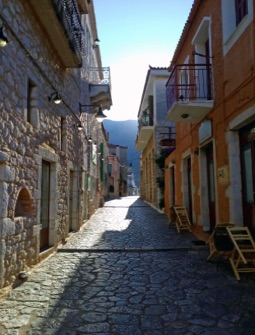MANI
The Mani peninsula, the middle finger of the three in the south of Peloponnese, is wild, beautiful and different. The steep and once nearly impassable mountain landscape was home to a violent and proud people, the maniotes. They built houses shaped like towers, to make them almost unconquerable to the enemy - but also because they needed to be safe from their neighbours; the feuds among them were many and hard and blood vengeance was the norm. Skilled warriors were created here, like Theodoros Kolokotronis, the general that more than anybody gets the honour of having freed Nafplio from the Turks.
It’s much more peaceful in the Mani these days, and a lot to explore, so it’s not a bad idea to go on a two or three days trip here.
The name Mani has, as you might guess, given us the words mania and maniac.

Vathia
Kardamyli harbour
Here you will find our suggestions for a tour of the peninsula Mani. You'll need to stay for a couple of days, and a car.
Wild beauty, wonderful villages
GYTHIO
We begin in the northeastern part of the Mani, in Gythio, a charming port town and major town in the Mani. Gythio has a long and colourful history, but was destroyed by earthquake in 375 AD. It began to grow again in the late 1800's, which the many neo-classical houses testify too. In Gythio it’s nice to just stroll around, or sit down at a cafe or tavern overlooking the bay. If you're hungry for history, visit the Museum of History and Ethnology at the sweet little island Kranai at the south part of the town. In the north you'll find the Archaeological Museum and a small, two thousand years old amphitheater. Fine beaches are also found near the town, we like Glyfada (also called Valtaki), it's long and nice and has a dramatic shipwreck at the water's edge.
THE SOUTHERNMOST EUROPE
We continue southwards. The landscape is changing, it becomes increasingly barren and wild for every mile, and small Byzantine churches and villages of tower houses tempt us to stop and admire them. Cape Tenaro, the southern tip of Mani, is the southernmost point of Europe's mainland. The scenery here is naked and magnificent, so do spend some time here, either taking a coffee in Porto Kagio, enjoy a beach or stroll all the way to the end of the cape.
VATHIA
Then we head north, on the west side of Mani, to Vathia, which probably is the most beautiful village in the area, and also the one who was most notorious for its internal feuding. While walking between the distinctive tower houses, you’ll soon see that most of them are abandoned, and unless you come at the same time as a bus load of tourists, you’ll notice there’s a both beautiful and sad mood here. At least we think so.
There's a newer building here that houses both a hotel and a cafe, only the cafe was open when we were here (2017) - and please have a beverage there, because the view is amazing!
FLOMOCHORI
You won't find this village in the guidebooks. This little gem is on the east coast of Mani, and it comes with a beautiful old town, a couple of cafes and a shop selling "everything". There are many such small villages along the east coast, but we present this because we like the ambiance and think it's so lovely to wander around the old town. Between Flomochori and Kotronas lies the charming pebble beach Chalikia Vata.
AGIOS NIKOLAOS, STOUPA and KARDAMYLI
These three villages are popular package tour destinations for Northern Europeans. First we come to Agios Nikolaos (pictured), which we think is the prettiest of the three, with its picturesque fishing port and beautiful old houses. Furthermore, we drive up to Stoupa, the British have embraced this one. Just north of Stoupa lies Kalogria beach, and in fact, Katzantzakis and Zorbas lived here when they started mining, even though the author has moved them to Crete in the book. At last, we end up in Kardamyli, which has a small, beautiful old town and a happy and lively main street.
Then you can continue your trip towards Areopoli, and possibly stop just south of it. There you'll find the Diros Caves, which embraces a portion of a river that flows through the mountains. This is a wonderful, magical place, always quiet, always pleasantly cool. Sitting on small boats, you will be rowed on the river, above the stalagmites and below the stalactites, that flashes and shines in beautiful colours. The caves, which was rediscovered about 100 years ago, was also known in the Stone Age and after, and once thought being part of the underworld. Well, for all we know, someone might still think they do.
You can learn more about the history at the Neolithic museum near the caves.
Areopoli is one of our favorite towns in Mani. It looks boring and nothing special when you approach it, but the old town is amazing, with lots of history in it's walls.
GEROLIMENAS
Gerolimenas means Sacred Port, which indicates that this has been an important place once in the past. Now, the small village of tavernas, bars, hotels and some residential houses has a strange and distinctive beauty that only has to be experienced. The beach breaks with turquoise sea, and it's all pretty wonderful.

DIROS CAVES and AREOPOLI
THE MOUNTAIN VILLAGES and VYROS GORGE
We have stayed on the main road that runs along the coast, now we will turn off on a winding little road that goes up the mountains between Kardamyli and Stoupa. Here lies many cute villages in a stunning nature, visit, for instance, Proastio, Exocori, Saidona and Kastania. We love Proastio the most (picture left) it's so beautiful, resting on a mountain side.
Just north of Exochori is Chora, a handful houses and a hotel called Faraggi. The picture below is taken from the hotel's terrace, there's a cafe that everyone can visit, and you can enjoy the views as seen below. This is the Vyros gorge, a mighty sight, where the highest mountain is 2200 meters. There is a hiking trail along the gorge from Chora, please use it!
